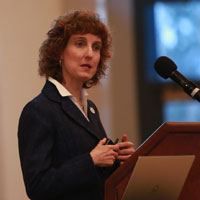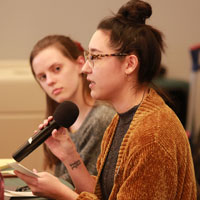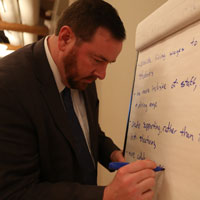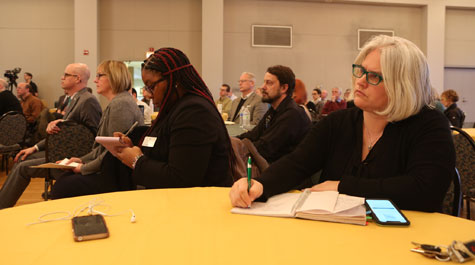W&M strategic planning subcommittees report on environmental analysis work
As part of William & Mary’s ongoing strategic planning process, three subcommittees shared overviews of their environmental scans with an audience of more than 120 people in the Sadler Center’s Chesapeake Ballroom, as well as many more watching through streaming video, on Jan. 30.
The strategic planning process is currently in its second phase, environmental analysis. The subcommittees' white papers and a reading list will be under review and refinement by the W&M community for the next four to six weeks before being integrated into the upcoming strategy development phase.
“This is a really critical inflection point,” said W&M President Katherine A. Rowe as she opened the session.
 Feedback is being collected throughout the planning process and is encouraged as part of the ongoing dialogue, according to officials. Provost Peggy Agouris, co-chair of the Strategic Planning Steering Committee, has invited all department chairs and program directors to engage their faculty members in reviewing and responding to the subcommittee reports. Assemblies representing faculty, staff and students will also collect and offer responses on behalf of their respective constituencies. The next community forum is set for Feb. 12 at 3:30 p.m. at the same site.
Feedback is being collected throughout the planning process and is encouraged as part of the ongoing dialogue, according to officials. Provost Peggy Agouris, co-chair of the Strategic Planning Steering Committee, has invited all department chairs and program directors to engage their faculty members in reviewing and responding to the subcommittee reports. Assemblies representing faculty, staff and students will also collect and offer responses on behalf of their respective constituencies. The next community forum is set for Feb. 12 at 3:30 p.m. at the same site.
Subcommittees in the areas of Teaching & Learning, Research & Innovation and Flourishing & Engagement collected information during the fall from W&M and external sources to put into their reports. Agouris said each subcommittee applied at least five lenses — diversity and inclusion, global, resources, sustainability and technology — to its scanning process and could add more as needed. They could also add committee members as topic experts and held at least 10 outreach meetings as part of their work.
The subcommittee for Teaching & Learning formed four working groups in the areas of curriculum pedagogy, contexts of learning, support for learning and outcomes of learning, explained co-chair Steve Hanson, vice provost for international affairs and director of the Reves Center for International Studies. The subcommittee added W&M’s reputation as an additional lens, and used four main questions to guide the working groups. Their summary findings identified cherished principles at W&M, trends in higher education, opportunities for change and ongoing challenges.
 The Research & Innovation subcommittee did external scans of leading institutions in those two areas. The group interviewed 24 people with nine key questions as outreach, according to co-chair Amy Sebring, vice president for finance and technology. Their summary findings in key areas recommended a clearly defined, well-communicated and well-executed strategy; organizational structures that promote collaboration; incentives and rewards; physical space and technology tools that support the work; and well-developed collaborations with external powers.
The Research & Innovation subcommittee did external scans of leading institutions in those two areas. The group interviewed 24 people with nine key questions as outreach, according to co-chair Amy Sebring, vice president for finance and technology. Their summary findings in key areas recommended a clearly defined, well-communicated and well-executed strategy; organizational structures that promote collaboration; incentives and rewards; physical space and technology tools that support the work; and well-developed collaborations with external powers.
“We were really cognizant of the fact that at the end of the strategic planning process, we want to be able to say we know what our goal is and we’ll know when we’ve achieved it,” Sebring said.
The Flourishing & Engagement subcommittee did an external scan of popular and higher education press and came up with eight themes that included changing demographics, diversity and belonging, the changing role and perception of higher education and wellness. An internal scan included interviews with 17 focus groups comprised of students, faculty and staff, according to co-chair Ginger Ambler, vice president for student affairs. Belonging and flourishing were the two key themes that emerged.
After the presentations, Rowe asked forum attendees to discuss which of the themes they had heard were most important, and then attendees who volunteered to do so reported to the larger group.
 Attendees repeatedly mentioned the importance of breaking down barriers and collaborating across departments or “silos” as well as exploring online learning opportunities for students and embracing change in the future. Rowe encouraged attendees to continue to think about the various topic areas and questions and to provide feedback to the Strategic Planning Steering Committee on the white papers and reading list.
Attendees repeatedly mentioned the importance of breaking down barriers and collaborating across departments or “silos” as well as exploring online learning opportunities for students and embracing change in the future. Rowe encouraged attendees to continue to think about the various topic areas and questions and to provide feedback to the Strategic Planning Steering Committee on the white papers and reading list.
“It seems to me there might be a project that this room could pursue, which is to identify the places where the silos are very productively bridged or integrated or broken down,” Rowe said.
 Skip to main content
Skip to main content

